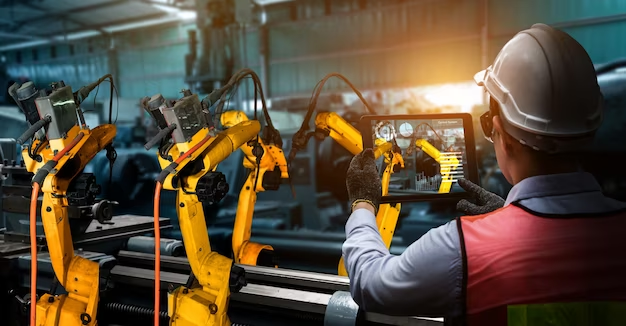In today's fast-paced and highly competitive industrial landscape, automation has become a critical driver of efficiency, productivity, and profitability. Industrial companies across various sectors are increasingly turning to automation solutions to streamline their operations, reduce costs, improve safety, and gain a competitive edge. This blog post explores the benefits, challenges, and best practices for implementing automation solutions in industrial companies.
- Understanding Automation in the Industrial Context:
Automation refers to the use of technology and control systems to perform tasks or processes with minimal human intervention. In an industrial setting, automation can encompass a wide range of applications, including robotics, machine learning, artificial intelligence, process control systems, and data analytics. These technologies can be applied to tasks such as production, assembly, material handling, quality control, inventory management, and predictive maintenance.
- The Benefits of Automation in Industrial Companies:
Enhanced Efficiency and Productivity:
By automating repetitive and time-consuming tasks, industrial companies can significantly improve efficiency and productivity. Automated systems can work faster and more accurately than humans, resulting in increased output and reduced cycle times. This allows companies to meet higher production demands while maintaining consistent quality standards. Cost Reduction:
Automation can lead to cost savings in several ways. By minimizing human intervention, companies can reduce labor costs and the associated expenses such as training, benefits, and turnover. Additionally, automation enables better resource utilization, optimized inventory management, and reduced waste, leading to lower operating costs and improved overall profitability.Improved Safety:
Industrial environments can be hazardous for workers, exposing them to various risks. Automation solutions can help mitigate these risks by taking over dangerous tasks or providing real-time monitoring and alerts. By reducing human exposure to potentially hazardous situations, companies can enhance workplace safety and minimize the occurrence of accidents and injuries.Quality Control and Consistency:
Automation systems are designed to perform tasks with a high degree of precision and accuracy. This consistency improves product quality and reduces defects, ensuring that the end products meet or exceed customer expectations. Automated inspection and testing processes can identify and address quality issues promptly, leading to improved customer satisfaction and brand reputation.Challenges in Implementing Automation Solutions:
While the benefits of automation are compelling, implementing automation solutions in industrial companies can pose challenges. It is essential to address these challenges effectively to maximize the success of automation initiatives. Some common challenges include:
Capital Investment:
Implementing automation solutions often requires significant upfront capital investment. Companies need to carefully evaluate the costs and benefits of automation projects to ensure a positive return on investment (ROI). Financial planning, including budget allocation and securing funding, becomes crucial to overcome this challenge.Workforce Transition and Training:
Automation can result in changes to job roles and responsibilities, potentially leading to workforce resistance or concerns about job security. It is crucial for companies to proactively address these concerns by providing training and upskilling opportunities to employees. This ensures a smooth transition and helps employees adapt to the changing work environment.Integration with Existing Systems:
Integrating new automation systems with existing infrastructure and software can be complex. Compatibility issues, data management, and interoperability must be carefully considered during the implementation process. Collaborating with experienced automation solution providers can help mitigate these integration challenges.Best Practices for Implementing Automation Solutions:
To maximize the success of implementing automation solutions, industrial companies should follow these best practices:
Clearly Define Goals and Objectives:
Clearly articulate the goals and objectives of the automation project. Whether it is improving productivity, reducing costs, or enhancing safety, having a well-defined purpose helps guide the implementation process and measure the success of the automation solution.Conduct a Comprehensive Needs Assessment:
Thoroughly assess the current processes, pain points, and areas for improvement before implementing automation. This evaluation will help identify the most suitable automation technologies and prioritize areas that will yield the greatest benefits.
Develop a Phased Implementation Strategy:
Instead of attempting a complete overhaul, break down the automation implementation into manageable phases. This approach allows for testing, refinement, and gradual adoption, reducing the risk of disruption to ongoing operations.Collaborate with Automation Solution Providers:
Engage with experienced automation solution providers who understand the specific needs and challenges of industrial companies. Their expertise can help in selecting the right technologies, designing tailored solutions, and providing ongoing support and maintenance.Invest in Workforce Training and Change Management:
Allocate resources for training programs and change management initiatives to prepare the workforce for the automation transition. Empowering employees with the necessary skills and knowledge fosters a positive work environment and promotes acceptance of automation technologies.Implementing automation solutions in industrial companies offers significant benefits in terms of efficiency, productivity, cost reduction, safety, and quality control. However, it is essential to address the challenges associated with automation effectively. By following best practices, such as clearly defining goals, conducting comprehensive assessments, and collaborating with experienced solution providers, companies can successfully integrate automation into their operations, driving sustainable growth and competitiveness in the dynamic industrial landscape.















